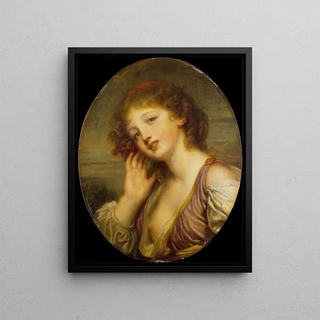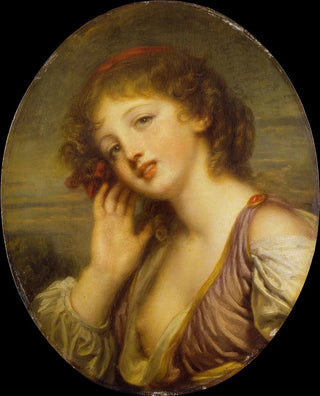Art print | The woman listening - Jean-Baptiste Greuze


View from behind

Frame (optional)
In the vast panorama of art history, certain works manage to transcend their era to become timeless witnesses of human emotions. "The Listening Woman - Jean-Baptiste Greuze" is undoubtedly one of these creations. This painting does not merely depict a female figure; it invites the viewer to immerse themselves in a moment of delicacy and contemplation. The woman, frozen in a posture of attentive listening, seems to catch invisible whispers, as if she were the bearer of a precious secret. Through this work, Greuze offers us a reflection on sensitivity and receptivity, qualities often highlighted in 18th-century art.
Style and uniqueness of the work
The uniqueness of "The Listening Woman" lies in Greuze's technical mastery, which manages to combine realism and idealization. The treatment of lights and shadows creates an intimate atmosphere, while the details of the face and clothing reveal meticulous attention to textures and expressions. The palette of soft colors, dominated by warm tones, enhances the emotional aspect of the scene. Every brushstroke seems charged with meaning, and the woman's posture, both natural and elegant, evokes a certain introspection. Greuze succeeds in capturing a universal human essence, allowing each observer to identify with this enigmatic figure. Furthermore, the choice to depict a woman in a moment of vulnerability and listening highlights a sensitivity that still resonates today, making the art print timeless.
The artist and his influence
Jean-Baptiste Greuze, an emblematic figure of the Rococo movement, knew how to mark his era with a style that blends emotion and storytelling. Born in 1725, he quickly established himself as one of the most appreciated painters of his time, notably thanks to his ability to depict scenes of daily life with rare psychological depth. Greuze drew inspiration from the great masters of the past while developing a personal approach, centered on the individual and their emotions. His influence extends beyond his time, inspiring generations of art enthusiasts.

Matte finish

View from behind

Frame (optional)
In the vast panorama of art history, certain works manage to transcend their era to become timeless witnesses of human emotions. "The Listening Woman - Jean-Baptiste Greuze" is undoubtedly one of these creations. This painting does not merely depict a female figure; it invites the viewer to immerse themselves in a moment of delicacy and contemplation. The woman, frozen in a posture of attentive listening, seems to catch invisible whispers, as if she were the bearer of a precious secret. Through this work, Greuze offers us a reflection on sensitivity and receptivity, qualities often highlighted in 18th-century art.
Style and uniqueness of the work
The uniqueness of "The Listening Woman" lies in Greuze's technical mastery, which manages to combine realism and idealization. The treatment of lights and shadows creates an intimate atmosphere, while the details of the face and clothing reveal meticulous attention to textures and expressions. The palette of soft colors, dominated by warm tones, enhances the emotional aspect of the scene. Every brushstroke seems charged with meaning, and the woman's posture, both natural and elegant, evokes a certain introspection. Greuze succeeds in capturing a universal human essence, allowing each observer to identify with this enigmatic figure. Furthermore, the choice to depict a woman in a moment of vulnerability and listening highlights a sensitivity that still resonates today, making the art print timeless.
The artist and his influence
Jean-Baptiste Greuze, an emblematic figure of the Rococo movement, knew how to mark his era with a style that blends emotion and storytelling. Born in 1725, he quickly established himself as one of the most appreciated painters of his time, notably thanks to his ability to depict scenes of daily life with rare psychological depth. Greuze drew inspiration from the great masters of the past while developing a personal approach, centered on the individual and their emotions. His influence extends beyond his time, inspiring generations of art enthusiasts.






